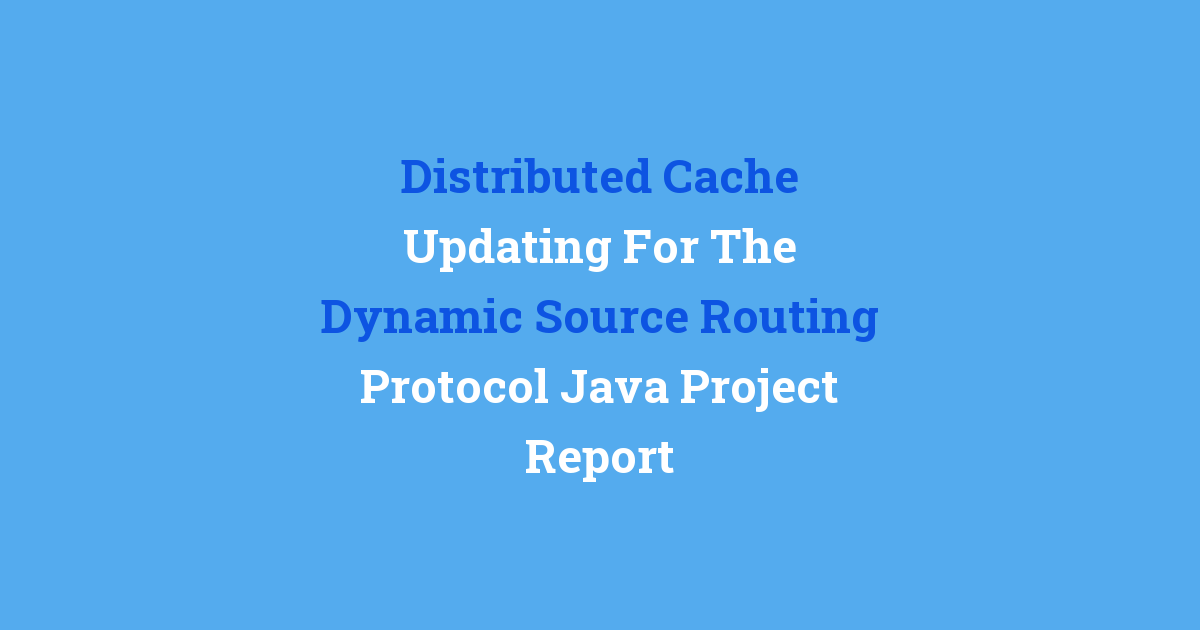Updating the distributed cache for the dynamic source routing protocol in the Java project report.
Introduction:
In the field of computer networks, efficient routing is crucial for ensuring the smooth and reliable transmission of data packets from source to destination. One of the commonly used routing protocols in ad-hoc networks is the Dynamic Source Routing (DSR) protocol. However, one of the challenges faced in DSR is the need for frequent updating of the route cache due to the dynamic nature of the network topology. To address this issue, the concept of distributed cache updating has been proposed. This project aims to implement distributed cache updating for the DSR protocol using Java to improve the efficiency of route caching in ad-hoc networks.
Problem Statement:
In the traditional DSR protocol, each node maintains a route cache that stores information about routes to various destinations in the network. However, as the network topology changes frequently in ad-hoc networks, the route cache needs to be updated regularly to ensure that packets are routed through the most efficient path. The frequent updating of the route cache poses a challenge in terms of overhead and delay in data transmission. Therefore, there is a need to develop a mechanism to update the route cache in a distributed manner to reduce the update overhead and improve the efficiency of routing in ad-hoc networks.
Existing System:
In the existing system, the route cache in DSR is updated by individual nodes based on the route discovery process. When a node wants to send a packet to a destination for which it does not have a route in its cache, it initiates a route discovery process to find a route to the destination. Once a route is discovered, it is stored in the route cache of the source node and intermediate nodes along the path. However, as the network topology changes, the routes stored in the cache may become stale, leading to packet loss and increased latency in data transmission.
Disadvantages:
1. High overhead: The traditional route cache updating mechanism in DSR incurs high overhead due to frequent route discoveries and cache updates.
2. Delay in data transmission: The overhead involved in route cache updating results in delays in data transmission, affecting the overall performance of the network.
3. Stale routes: The route cache may contain stale routes that result in packet loss and increased latency in routing packets to their destinations.
4. Inefficiency: The existing route cache updating mechanism in DSR is inefficient in handling dynamic network topologies, leading to suboptimal routing paths.
Proposed System:
To address the limitations of the existing system, we propose a distributed cache updating mechanism for the DSR protocol. In the proposed system, instead of relying solely on individual nodes for cache updating, the updating process is distributed among multiple nodes in the network. When a node detects a change in the network topology, it broadcasts a cache update message to its neighboring nodes, informing them of the change. The neighboring nodes then update their route caches accordingly, ensuring that all nodes have up-to-date routing information.
Advantages:
1. Reduced overhead: By distributing the cache updating process, the proposed system reduces the overhead associated with frequent route discoveries and cache updates.
2. Improved efficiency: The distributed cache updating mechanism improves the efficiency of routing in ad-hoc networks by ensuring that all nodes have current routing information.
3. Faster data transmission: With up-to-date route caches, data packets can be routed through the most efficient paths, reducing latency and improving the overall performance of the network.
4. Minimized packet loss: By updating the route cache in a timely manner, the proposed system helps prevent packet loss due to stale routes in the cache.
Features:
1. Distributed cache updating: The proposed system distributes the cache updating process among multiple nodes in the network to reduce overhead and improve efficiency.
2. Route cache synchronization: Nodes synchronize their route caches with neighboring nodes to ensure that all nodes have consistent routing information.
3. Dynamic topology adaptation: The system adapts to changes in the network topology by updating the route cache in real-time, ensuring optimal routing paths for data packets.
4. Fault tolerance: The distributed cache updating mechanism is designed to be fault-tolerant, ensuring reliable operation even in the presence of node failures or network disruptions.
Conclusion:
In conclusion, the implementation of distributed cache updating for the DSR protocol using Java offers a promising solution to the challenges of route caching in ad-hoc networks. By distributing the cache updating process among multiple nodes, the proposed system reduces overhead, improves efficiency, and enhances the reliability of data transmission. With its dynamic topology adaptation and fault tolerance features, the system is well-equipped to handle the dynamic nature of ad-hoc networks and provide optimal routing paths for data packets. Overall, the proposed system has the potential to significantly improve the performance of the DSR protocol in ad-hoc networks and pave the way for future advancements in routing protocols.

